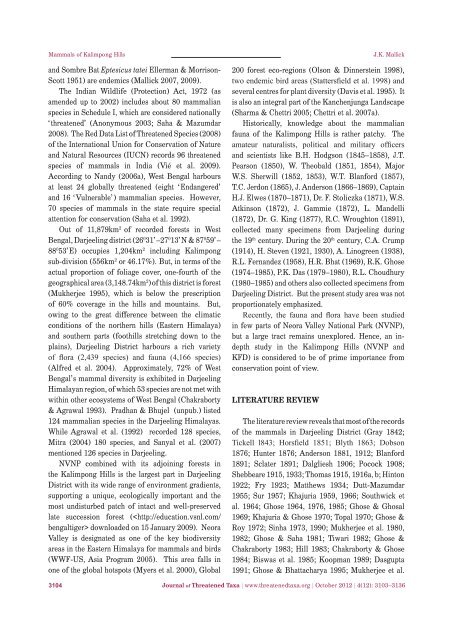October 2012 - Journal of Threatened Taxa
October 2012 - Journal of Threatened Taxa
October 2012 - Journal of Threatened Taxa
Create successful ePaper yourself
Turn your PDF publications into a flip-book with our unique Google optimized e-Paper software.
Mammals <strong>of</strong> Kalimpong Hillsand Sombre Bat Eptesicus tatei Ellerman & Morrison-Scott 1951) are endemics (Mallick 2007, 2009).The Indian Wildlife (Protection) Act, 1972 (asamended up to 2002) includes about 80 mammalianspecies in Schedule I, which are considered nationally‘threatened’ (Anonymous 2003; Saha & Mazumdar2008). The Red Data List <strong>of</strong> <strong>Threatened</strong> Species (2008)<strong>of</strong> the International Union for Conservation <strong>of</strong> Natureand Natural Resources (IUCN) records 96 threatenedspecies <strong>of</strong> mammals in India (Vié et al. 2009).According to Nandy (2006a), West Bengal harboursat least 24 globally threatened (eight ‘Endangered’and 16 ‘Vulnerable’) mammalian species. However,70 species <strong>of</strong> mammals in the state require specialattention for conservation (Saha et al. 1992).Out <strong>of</strong> 11,879km 2 <strong>of</strong> recorded forests in WestBengal, Darjeeling district (26 0 31’–27 0 13’N & 87 0 59’–88 0 53’E) occupies 1,204km 2 including Kalimpongsub-division (556km 2 or 46.17%). But, in terms <strong>of</strong> theactual proportion <strong>of</strong> foliage cover, one-fourth <strong>of</strong> thegeographical area (3,148.74km 2 ) <strong>of</strong> this district is forest(Mukherjee 1995), which is below the prescription<strong>of</strong> 60% coverage in the hills and mountains. But,owing to the great difference between the climaticconditions <strong>of</strong> the northern hills (Eastern Himalaya)and southern parts (foothills stretching down to theplains), Darjeeling District harbours a rich variety<strong>of</strong> flora (2,439 species) and fauna (4,166 species)(Alfred et al. 2004). Approximately, 72% <strong>of</strong> WestBengal’s mammal diversity is exhibited in DarjeelingHimalayan region, <strong>of</strong> which 53 species are not met withwithin other ecosystems <strong>of</strong> West Bengal (Chakraborty& Agrawal 1993). Pradhan & Bhujel (unpub.) listed124 mammalian species in the Darjeeling Himalayas.While Agrawal et al. (1992) recorded 128 species,Mitra (2004) 180 species, and Sanyal et al. (2007)mentioned 126 species in Darjeeling.NVNP combined with its adjoining forests inthe Kalimpong Hills is the largest part in DarjeelingDistrict with its wide range <strong>of</strong> environment gradients,supporting a unique, ecologically important and themost undisturbed patch <strong>of</strong> intact and well-preservedlate succession forest ( downloaded on 15 January 2009). NeoraValley is designated as one <strong>of</strong> the key biodiversityareas in the Eastern Himalaya for mammals and birds(WWF-US, Asia Program 2005). This area falls inone <strong>of</strong> the global hotspots (Myers et al. 2000), GlobalJ.K. Mallick200 forest eco-regions (Olson & Dinnerstein 1998),two endemic bird areas (Stattersfield et al. 1998) andseveral centres for plant diversity (Davis et al. 1995). Itis also an integral part <strong>of</strong> the Kanchenjunga Landscape(Sharma & Chettri 2005; Chettri et al. 2007a).Historically, knowledge about the mammalianfauna <strong>of</strong> the Kalimpong Hills is rather patchy. Theamateur naturalists, political and military <strong>of</strong>ficersand scientists like B.H. Hodgson (1845–1858), J.T.Pearson (1850), W. Theobald (1851, 1854), MajorW.S. Sherwill (1852, 1853), W.T. Blanford (1857),T.C. Jerdon (1865), J. Anderson (1866–1869), CaptainH.J. Elwes (1870–1871), Dr. F. Stoliczka (1871), W.S.Atkinson (1872), J. Gammie (1872), L. Mandelli(1872), Dr. G. King (1877), R.C. Wroughton (1891),collected many specimens from Darjeeling duringthe 19 th century. During the 20 th century, C.A. Crump(1914), H. Steven (1921, 1930), A. Linogreen (1938),R.L. Fernandez (1958), H.R. Bhat (1969), R.K. Ghose(1974–1985), P.K. Das (1979–1980), R.L. Choudhury(1980–1985) and others also collected specimens fromDarjeeling District. But the present study area was notproportionately emphasized.Recently, the fauna and flora have been studiedin few parts <strong>of</strong> Neora Valley National Park (NVNP),but a large tract remains unexplored. Hence, an indepthstudy in the Kalimpong Hills (NVNP andKFD) is considered to be <strong>of</strong> prime importance fromconservation point <strong>of</strong> view.LITERATURE REVIEWThe literature review reveals that most <strong>of</strong> the records<strong>of</strong> the mammals in Darjeeling District (Gray 1842;Tickell l843; Horsfield 1851; Blyth 1863; Dobson1876; Hunter 1876; Anderson 1881, 1912; Blanford1891; Sclater 1891; Dalgliesh 1906; Pocock 1908;Shebbeare 1915, 1933; Thomas 1915, 1916a, b; Hinton1922; Fry 1923; Matthews 1934; Dutt-Mazumdar1955; Sur 1957; Khajuria 1959, 1966; Southwick etal. 1964; Ghose 1964, 1976, 1985; Ghose & Ghosal1969; Khajuria & Ghose 1970; Topal 1970; Ghose &Roy 1972; Sinha 1973, 1990; Mukherjee et al. 1980,1982; Ghose & Saha 1981; Tiwari 1982; Ghose &Chakraborty 1983; Hill 1983; Chakraborty & Ghose1984; Biswas et al. 1985; Koopman 1989; Dasgupta1991; Ghose & Bhattacharya 1995; Mukherjee et al.3104<strong>Journal</strong> <strong>of</strong> <strong>Threatened</strong> <strong>Taxa</strong> | www.threatenedtaxa.org | <strong>October</strong> <strong>2012</strong> | 4(12): 3103–3136

















